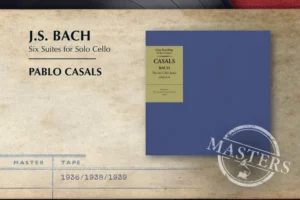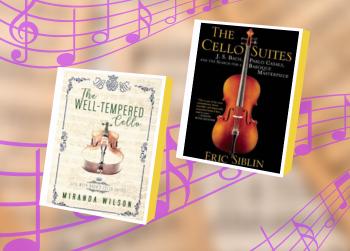Bach’s Six Suites for Solo Violoncello (BWV1007-1012) form one of his greatest musical monuments. The suites, and their constituent preludes and dances are essential to every cellist, and the moment when a cello student learns their first Minuet, Gigue, or Allemande, is the start of a long, challenging journey. In his biography of Bach from 1802 Johann Nikolaus Forkel noted that:
There are few instruments for which Bach has not composed something. In his time, it was usual to play in the church, during communion, a concerto or solo upon some instrument. He often wrote such pieces himself, and always contrived them so that his performers could, by their means, improve upon their instruments. Most of these pieces, however, are lost. But, on the other hand, two principal works of another kind have been preserved, which, in all probability, richly indemnify us for the loss of the others. For a long series of years, the Violin Solos were universally considered by the greatest performers on the violin as the best means to make an ambitious student a perfect master of his instrument. The solos of the violoncello are, in this respect, of equal value.” Nikolaus Forkel, Johann Sebastian Bach: his life, art, and work
It is unclear when Bach wrote the cello suites; there is much debate about whether they pre- or post-date the solo violin sonatas and partitas. Similarly, we do not know whether he composed all six suites consecutively, or whether they were a project Bach completed over time. The same uncertainty applies to the solo violin works, although in their case there exists a fair copy in Bach’s hand, dated 1720. Bach’s second wife, Anne Magdelene made another copy between 1727 and 1731, for which Bach’s pupil Schwanenberg wrote the frontispieces. It appears that Anne Magdelene’s copy of the suites for cello dates from the same time, possibly intended to be one volume with the violin solos, but Schwanenberg later wrote another frontispiece for them: 6 Suites, a Violoncello Solo senza Basso composes par Sr. J. S. Bach, Maitre de Chapelle. Other copies of the violin and cello solos were made by Bach’s associate, Johann Peter Kellner.
The dates of copies do not, unfortunately, help with the chronology of the cello suites themselves, but there is evidence in Bach’s Weimar cantatas, specifically BWV172, 132, and 163, which date from 1714-1715, that Bach worked with very able cellists. Cello virtuosity was not unknown in the German lands at this time, particularly as some of Vivaldi’s early cello concerti were circulating. There is too the question of whether some virtuoso viol players also played the cello: not only were they conversant with the extremely difficult viol music that emerged from France, by Marais and Forqueray, but there was also a Germanic school of viol playing, exemplified by the works of Johann Schenk’s Scherzi Musicali (published in 1689), which combined elements of the stylus phantasticus with French dances, and Italian virtuosity.
Today, the pedagogical value of the cello Suites remains undiminished, including not only the study of technical challenges, but also mastery of harmony or counterpoint, phrasing, melodic gesture, and rhetorical eloquence. Possessed of ingenious variety, Bach’s suites grow in technical difficulty. Their systematic elaboration is typical of Bach’s pedagogical approach to his instrumental music: not only does he provide a series of pieces of progressive difficulty, contrasting keys, and divergent moods, he also presents us with individual movements that teach us about the spirit and ideal of the gigue, the sarabande, the allemande, the bourrée, etc. The suites are still a cornerstone of every cellist’s concert repertoire, as the variety of recordings (spanning more than eight decades) in the collection of Wellington City Libraries demonstrates:
Six Evolutions: Bach Cello Suites / Bach, Johann Sebastian
Yo-Yo Ma’s Six Evolutions is also his third recording of Bach’s cello suites, and the release of the CDs in 2018 marked the beginning of Ma’s two-year ‘global Bach journey’ in which he would perform the six suites in 36 different locations, creating moments of shared understanding between cultures. The project in its original form was disrupted by the COVID-19 pandemic, but this recording is a testament to Ma’s long (and ever-changing) relationship with Bach’s music. He has characterised his first recording of the suites, made in his 20s, as a ‘youthful “I know everything.”‘ and the second recording as middle-aged confusion.’ Ma’s Six Evolutions offers a synthesis of these two states: a confidence born of six decades playing this music, and wonderment at what the music continues to offer.
 Cello suites / Bach, Johann Sebastian
Cello suites / Bach, Johann Sebastian
Alisa Weilerstein waited a little longer than Yo-Yo Ma to make her first recording of Bach’s Suites, and admitted that she had not planned to embark on such a project until she was ‘much older’. However, her timing seems to have been impeccable: her interpretation of each suite is characterized by evidence of deep consideration of Bach’s harmonies and melodic lines, enhanced by her lively and resonant tone. Weilerstein brings out the wit of Bach’s music, its jests and rhetorical asides, as well as the deep desolation found in the C minor Suite (BWV1011).
The Cello Suites / Bach, Johann Sebastian
Alban Gerhardt notes that he saw this making this recording as his ‘ultimate challenge’. While he happily performs the suites in concert, their ‘transcendental beauty paired with an enchanting simplicity has meant that I’ve never felt quite ready to actually “set them in stone” and record them.’ Encouraged by the director of Hyperion Records, Simon Perry, Gerhardt set aside his misgivings and set his performance of the suites into stone. His goal was to infuse his rendition of the suites with a sense of improvisatory spontaneity, ensuring that the technical complexities of bowing and articulation never intrude upon the lucidity of Gerhardt’s music-making.
Cello Suites / Bach, Johann Sebastian
Rachel Podger’s is the first recording of Bach’s cello suites transcribed for violin, a project that presented Podger with opportunities and challenges. As one of the leading historical performance specialists of the day, Podger’s playing is impeccable: her tone is clear and rich, and the quicker response of the violin’s strings (as compared to the strings of a cello) makes for a zingy rendering of the suites. The result is a recording that is diverting, revealing, and may inspire partisan reactions among its listeners!
 Cello Suites / Bach, Johann Sebastian
Cello Suites / Bach, Johann Sebastian
David Watkin — a leading exponent of historically informed performance, and renowned as a performer and teacher — has made a recording of Bach’s suites that is frequently joyous, illuminating details of the music that gratify the ear in unexpected ways. He performs Suites 1-5 on a cello made by Francesco Ruggieri, c. 1670, and he plays Suite No. 6 on a five-string cello by Antonio and Hieronymous Amati, dating from c. 1600. Using gut strings, and a bow modeled on one made in 1725 by Tonati, Watkin’s set-up is remarkably close to what a musician in Bach’s lifetime may have used to play Bach’s suites (although it is still uncertain for whom he composed them), but while the sound of this historically significant instruments connects Watkin with the music in a unique way, more important is the immediacy of Watkin’s playing, blending formal rhetoric with conversational intimacy.
The Well-Tempered Cello: life with Bach’s cello suites / Wilson, Miranda
Miranda Wilson is Professor of Cello at the Lionel Hampton School of Music, University of Idaho, where she is active as a teacher, performer, and author. However, her early training took place in Wellington, and it was in her teacher’s studio in Khandallah that Wilson first encountered Bach’s cello suites. Her book The Well-Tempered Cello traces Wilson’s study with different teachers in New Zealand, the United Kingdom, and the USA, working intensively in a string quartet, and the challenges of establishing a musical career. She weaves Bach’s music into this narrative arc, exploring each cello suite in turn, discussing the forms and history of the dances, unpicking the influence of Bach’s devout Lutheranism on his music, the synthesis of French and Italian musical elements in the suites, and the technical challenges of learning and memorizing the music for performance. Deftly weaving together memoir with musicology, The Well-Tempered Cello is a candid, human account of the significance of Bach’s cello music.
 Six Suites for Solo Cello / Bach, Johann Sebastian
Six Suites for Solo Cello / Bach, Johann Sebastian
No survey of recordings of Bach’s cello suites would be complete without Pablo Casals. The renowned violinist, chamber musician, and teacher, Felix Galimir, said of Casals’ performances of Bach’s solo suites: ‘He plays the Bach suites like I breathe, or sleep, and it sounds so – effortless seems a bad word – but it’s the most … effortless way of playing without being non-committal … I personally have always considered him the symbol of the noblest and most elegant string playing that I have ever heard.’ These qualities — ease, nobility, and elegance — are captured in Casals’ recording of the suites, made between 1936 and 1939. These CDs represent a benchmark in recording history, being the first recordings made of Bach’s cello suites; for nearly 90 years, Casals’ achievement has been a source of inspiration to generations of cellists.
The Cello Suites : J.S Bach, Pablo Casals and the search for a baroque masterpiece / Siblin, Eric
While Bach’s cello suites are now integral to the training and repertoire of every cellist, just a century ago, this was not the case. The suites were regarded as somewhat quaint, best suited to pedagogical needs; some cellists felt that the solo scoring was somehow lacking and they would play the suites with piano accompaniment. Much has changed in the intervening decades. Siblin traces the performance and recording history of Bach’s suites alongside the political and cultural circumstances in which this music was written and has been performed and recorded, from Bach’s life in German principalities that were still recovering from the upheavals of the Thirty Years’ War to Casals’ resistance against fascism in the 1930s, and Mstislav Rostropovich’s impromptu performance of Bach when the Berlin Wall came down in 1989.
6 Suites for Violoncello, BWV 1007-1012 / Bach, Johann Sebastian
First released in 1961, this was for many years a landmark recording of Bach’s suites for solo cello, until Pierre Fournier’s interpretation fell from favour with some musicians for its overt romanticism, when some tastes shifted to more austere (but arguably no more authentic) performances of Bach’s solo string music in a historically informed manner. However, Fournier’s presentation of the Suites is one that demands and rewards re-examination.
The Bach Cello Suites : a Companion / Isserlis, Steven
Steven Isserlis has now been performing Bach’s suites for decades and recorded them for Hyperion in 2005–2006. More recently, he wrote this Companion to the suites, and throughout the book, he references his recording as a means of illustrating points of discussion in the book. The Bach Cello Suites: A Companion is partly the culmination of many years’ familiarity with the suites, and alongside his own insights into the significance of the music, Isserlis also offers advice to aspirant performers, faced with climbing Bach’s musical Everest. He acknowledges that the suites have acquired an almost mystical aura, but also reminds us “Don’t be scared of Bach—he’s not scared of you,” — advice Isserlis also tempers by admitting that he still feels daunted by the manifold complexities (technical, expressive, and spiritual) of Bach’s music. This book, however, is not just for musicians; Isserlis offers something to professionals, amateurs, enthusiasts, and newcomers to Bach’s music.


